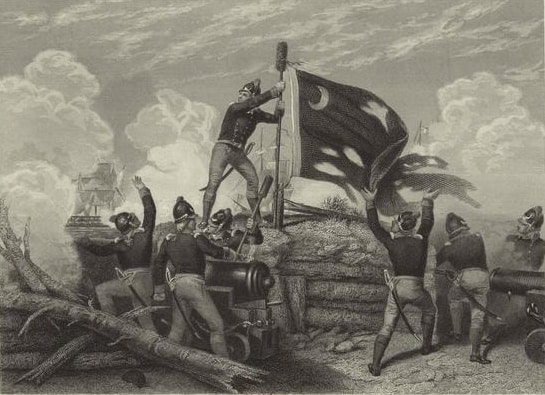Date: October through December 1775
Region: Southern Colonies
Commanders: British - Colonel Thomas Fletchall and Patrick Cunningham.
American - Colonel Richard Richardson, Colonel William "Danger" Thomson, and Major Andrew Williamson

British Perspective: The battles conducted during the 1775 Snow Campaign were all waged by American colonists living in a wild region of northwestern South Carolina known as the Upcountry. Within these forested foothills, the colonists had pushed the Indians westward and established settlements.
The beginning of the American Revolution divided these people into Loyalists (Tories), who supported the Crown and English rule, and Rebels or Patriots, who desired independence. The Loyalist movement within this backwoods region was led by Col. Thomas Fletchall, who organized a loose military organization to counter pro-patriot militia operating in the area. Another fervent Loyalist leader was Maj. Patrick Cunningham. While these Upcountry Loyalists received little support from the British, they maintained a dogged presence and engaged in brutal fighting against the Patriot militia throughout the American Revolution.
In October of 1775, in District Ninety-Six, Loyalist leader Patrick Cunningham and 60 of his men seized a South Carolina colonial militia wagon train laden with 2,000 pounds of lead and 1,000 pounds of gunpowder. Intended as a peace gesture, the supplies were being delivered to the Cherokee Indians from Charleston, South Carolina.
The Loyalists not only gained a fat prize but threatened to upset the delicate balance of peace the local settlers needed to maintain with their Indian neighbors. Throughout the war, British Indian agents also maintained a delicate relationship with the Cherokees, and Cunningham worked diligently to keep the Indians aligned with the British and Tories and opposed the Patriots. The seizure of the wagons prompted the South Carolina militia to organize; the Loyalists decided to attack and destroy them.
American Perspective: Prior to 1755, Indians occupied the Upcountry region of South Carolina and the land northwest of it. However, as pioneers moved into the area in the mid-1750s, the settlers made close friends with the friendly Siouan Catawbas and established a peace treaty with the more aggressive Cherokees. The result was a steady influx of white settlers and the establishment of outposts throughout the area during the next twenty years. Occasional war parties attacked white settlers when the latter encroached into favorite Indian hunting grounds. The ever-westward push of the pioneers created friction between the Indians and the settlers.
When the American Revolution began, the Upcountry region was still remote and dangerous. In order to provide protection for the settlers, a string of forts was constructed by the colonial government throughout District Ninety-Six. These forts included Fort George, Fort Prince, Earle’s Fort, Poole’s Fort, Anderson’s Block House, Nichols’ Fort, and Thickety Fort.
After the war began, the Patriot inhabitants found themselves fighting Indians, British Regulars, and the local Tory militia. An especially contested region was a large district known as Ninety-Six, where Tory raiders in October of 1775 seized colonial militia supply wagons. This action prompted Maj. Andrew Williamson called out the local Patriot militia, which mustered a respectable 562 men. Major Williamson and his men established a hastily constructed fort near the settlement of Ninety-Six (in District Ninety-Six).
The Battle: On November 19, 1775, the Loyalists attacked the Patriot fort at Ninety-Six. For the next two days, the Patriots defended an 85’ x 150’ log palisade reinforced with earthen berms on the north and northwestern walls. The two-day siege ended with just one man killed and four men wounded. The battle, however, marked the beginning of a lengthy and bloody struggle.
Neither side was prepared for war in the Upcountry, especially a long one. A temporary truce gave each time to organize better. During the next few weeks, volunteers joined either Tory or Patriot militias and prepared for battle. Colonel Richard Richardson and Col. William “Danger” Thomson rushed to the assistance of Major Williamson at Fort Ninety-Six.
Their combined force numbered about 4,000 men. After adequately manning and improving their defensive posts, they planned to assault the Tory militia. Meanwhile, Maj. Patrick Cunningham and Col. Thomas Fletcher combined their own militia, and the Tory force in District Ninety-Six also swelled to several thousand. Knowing they were not as strong as their Patriot opponents, however, the Tories or “King’s Men” did not aggressively seek to fight as an army.
Despite the cold winter weather, in December of 1775, the Patriot army attempted to surprise the enemy by attacking Tory camps. The Loyalists avoided battle by moving deeper into the forests. Patriot scouts were dispatched to find them, and a large Tory encampment was discovered on Great Cane Brake, a tributary of the Reedy River.
This area was located in the Cherokee Territory. On December 22, Colonel Thomson led his 3rd Ranger Regiment on a surprise assault on the Tory encampment. Despite heavy rain, sleet, and frigid temperatures, the Rangers moved stealthily through the dark hours of the early morning and crept toward their enemy. By dawn, they had surrounded the Tories, but alert sentinels in the Tory camp detected the approaching Patriots.
A brisk battle erupted. The Tories had at least one eye focused on escape, and after a short running fight, the combat ended with the Patriots in possession of the field.
For more in-depth research about the Snow Campaign, read the book Guide to the Battles of the American Revolution written by Theodore Savas and J. David Dameron.
Online Resources
- Wikipedia - Snow Campaign
- Guide To The Battles of the American Revolution
- Library of Congress Collection of Revolutionary War Maps
- West Point Battle Maps of the American Revolution
- Journal of the American Revolution
- How to Research Your Revolutionary War Ancestor
- The History Junkie’s Guide to the American Revolutionary War
- The History Junkie’s Guide to American Revolutionary War Battles
- The History Junkie’s Guide to the American Revolutionary War Timeline
- The History Junkie’s Guide to the 13 Original Colonies
